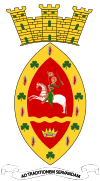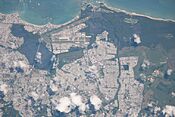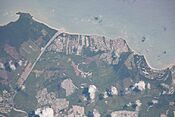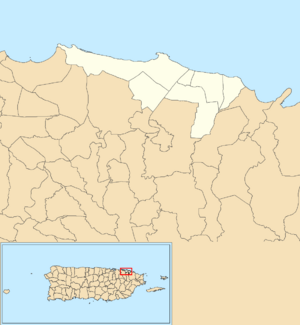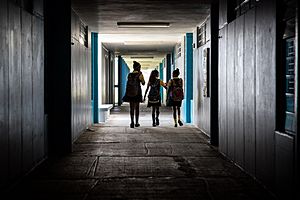Loíza, Puerto Rico facts for kids
Quick facts for kids
Loíza
Municipio de Loíza
|
|||
|---|---|---|---|
|
Town and Municipality
|
|||
|
Loíza City Hall
Loíza Parish
Loíza High School
Food kiosk in Piñones
Piñones beaches in Torrecilla Baja
|
|||
|
|||
| Nickname(s):
"El Pueblo de la Cacica"
|
|||
| Anthem: "Loiceños en Acción" | |||

Map of Puerto Rico highlighting Loíza Municipality
|
|||
| Sovereign state | |||
| Commonwealth | |||
| Settled | 16th century | ||
| Founded | August 16, 1692 | ||
| Named for | Yoisa | ||
| Barrios | |||
| Area | |||
| • Total | 65.71 sq mi (170.19 km2) | ||
| • Land | 19.44 sq mi (50.36 km2) | ||
| • Water | 46.27 sq mi (119.83 km2) | ||
| Population
(2020)
|
|||
| • Total | 23,693 | ||
| • Rank | 50th in Puerto Rico | ||
| • Density | 360.565/sq mi (139.215/km2) | ||
| Demonym(s) | Loiceño (masculine) Loiceña (feminine) |
||
| Time zone | UTC−4 (AST) | ||
| ZIP Code |
00772
|
||
| Area code(s) | 787/939 | ||
| Major routes | |||
Loíza is a town and municipality located on the northeastern coast of Puerto Rico. It sits east of Carolina and west of Río Grande. Loíza is famous for its strong Afro-Puerto Rican culture and history.
Many people visit Loíza for its delicious street food kiosks, beautiful beaches, and the Piñones State Forest. This forest is full of Australian pine and mangrove trees.
Contents
History of Loíza
The name Loíza might come from a female cacique (a native chief) named Loaíza or Yuíza. She ruled the area once known as Haimanio, near the Río Grande de Loíza. Some stories say she married a mulatto conquistador named Pedro Mejías, but there's no proof. Other ideas suggest the name came from a Spanish landowner, Iñigo López de Cervantes y Loayza. He owned much of the land and was well-known at the time.
In 1692, Loíza was recognized as an urban area because it had grown to 100 houses and 1,146 people. The Spanish government officially made it a town in 1719. Gaspar de Arredondo founded the town.
After the Spanish–American War, Puerto Rico became a territory of the United States in 1898. A census in 1899 showed that Loíza had a population of 12,522 people.
In 2017, Hurricane Maria caused a lot of damage in Loíza. Many homes lost their roofs or were completely destroyed. In 2018, the TV show Bar Rescue helped the community. They fixed a local community center, a playground, and sports fields, showing how people came together to rebuild.
Geography of Loíza
Loíza is part of Puerto Rico's northern coastal plains. The land is mostly flat, not rising more than 100 meters (about 328 feet) above sea level.
The United States Census Bureau states that Loíza covers about 170 square kilometers (65.71 square miles). About 50 square kilometers (19.44 square miles) is land, and the rest is water.
What are the Barrios of Loíza?
Like all municipalities in Puerto Rico, Loíza is divided into smaller areas called barrios. The main town area, with its government buildings and church, is called ""el pueblo"".
The barrios in Loíza are:
Special Communities in Loíza
Some areas in Puerto Rico are called Special Communities. These are places where people might face challenges like social exclusion. In 2014, several communities in Loíza were on this list. These included areas like Miñi Miñi Piñones and Villa Cañona.
In 2020, the mayor of Loíza announced that money from FEMA (Federal Emergency Management Agency) would be used for construction projects. The biggest project is to improve the Miñi Miñi Sector in the Medianía Baja barrio.
Population and People of Loíza
Loíza's population was 23,693 in the 2020 census. The municipality has a high number of Afro-Puerto Ricans. In 2000, about 4,256 residents spoke English as their first language.
| Race - Loíza, Puerto Rico - 2020 Census | ||
|---|---|---|
| Race | Population | % of Total |
| White | 1,376 | 5.8% |
| Black/Afro-Puerto Rican | 7,533 | 31.8% |
| American Indian and Alaska Native | 106 | 0.4% |
| Asian | 21 | 0.1% |
| Native Hawaiian/Pacific Islander | 0 | 0.0% |
| Some other race | 3,689 | 15.6% |
| Two or more races | 10,968 | 46.3% |
Things to See and Do in Loíza
Loíza has 19 beautiful beaches to explore. In May 2020, the Parque Julia de Burgos (Julia de Burgos Park) opened, offering a new place for visitors.
Other fun places to visit in Loíza include:
- Aviones Beach
- Ayala Family Artesan Center (for local crafts)
- Julia de Burgos Walk
- María de la Cruz Cavern
- Piñones Lagoon
- San Patricio Parish
- Vacía Talega Beach
- Samuel Lind Estudio de Arte (Samuel Lind Art Studio)
Culture and Traditions of Loíza
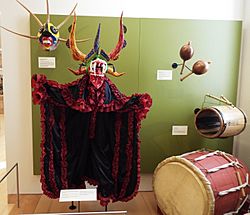
Loíza is known as "La Capital de la Tradición" (Capital of Traditions). It's famous for its bomba music, traditional Taíno and African dishes, and unique folk art. One of its barrios, Loíza aldea, is especially known for its talented dancers and artists. It's also considered a birthplace of the musical style called plena.
Each year, Loíza hosts a special celebration. People parade wearing Máscaras de Vejigante. These are colorful masks made from coconuts.
Festivals and Events in Loíza
Loíza celebrates its patron saint festival in March. The Fiestas Patronales de San Patricio is a religious and cultural event. It usually includes parades, games, local crafts, rides, traditional food, and live music.
Other festivals and events in Loíza are:
- Mayombe Carnival – held in February
- Festival of Saint James the Apostle – held in July
Economy of Loíza
Agriculture in Loíza
Farmers in Loíza grow coconuts, various fruits, sugar canes, and apples.
Industry in Loíza
Fishing is an important industry in Loíza.
Symbols of Loíza
The municipality of Loíza has its own official flag and coat of arms.
Loíza Flag
The flag is green, gold, and red with three wavy stripes. In the top left corner, a bell tower represents religious traditions and the historic Church of San Patricio.
Loíza Coat of Arms
The coat of arms features Saint James the Apostle on horseback. This shows the strong devotion people in Loíza have for the saint, especially during their traditional festivities on July 25. The flames symbolize the Holy Spirit, which is part of the old church's name. A wavy stripe represents the Grande de Loíza River, an important part of Puerto Rico's geography and history. The crown stands for the famous Taína Chief Yuisa, who lived and died in Loíza. The shamrocks represent Saint Patrick of Ireland, who is the patron saint of the town.
Education in Loíza
The Department of Education of Puerto Rico manages schools in Loíza. Loíza has several elementary schools, two junior high schools, and two high schools.
Transportation in Loíza
You can get to Loíza from San Juan using the AMA route D45. This bus goes to Piñones and Isla Verde. It also connects to the Tren Urbano (urban train) at the Sagrado Corazon station.
There isn't much public transportation connecting Loíza to cities further east in Puerto Rico. While Loíza itself has few hotels, there are resorts in nearby Rio Grande.
Loíza has 5 bridges that help people travel around the area.
Images for kids
See also
 In Spanish: Loíza para niños
In Spanish: Loíza para niños









